Most recent
ASCE MOP 145-2021
Design of Close-Fit Liners for the Rehabilitation of Gravity Pipes
Prepared by the Pipeline Infrastructure Committee of the Utility Engineering and Surveying Institute of ASCE
Design of Close-Fit Liners for the Rehabilitation of Gravity Pipes, MOP 145, provides a comprehensive source of information on the design of flexible, close-fit linings for the renewal or rehabilitation of pipes designed for gravity flow such as sanitary sewers, culverts, and storm sewers.
Introductory topics discussed include pipe-soil structure interaction, condition assessment and inspection methods, and lining options, but the main focus is on the thickness design of close-fit flexible liners. This design is based on a closed-form solution, which takes into account both the current shape of the host structure as well as the potential imperfections of the liner (annular gap) and of the host structure (cracks or fractures).
The design solutions presented can be used for circular and noncircular geometries such as pipe-arch shapes, egg shapes, elliptical shaped pipes (both horizontal and vertical), box shaped pipes (both rectangular and square), and other, undefined site-specific shapes.
This Manual of Practice covers the thickness design of flexible liners to be installed in a gravity-flow sewer or culvert pipe; the host pipe can be rigid or flexible and be circular or noncircular; the installation method is trenchless and yields a close-fit lining, cured-in-place lining, or fold-and-form lining.
MOP 145 will provide guidance to consulting engineers tasked with designing flexible close-fit liners for rehabilitation of existing gravity pipe applications.
ASCE: American Society of Civil Engineers [asce]

